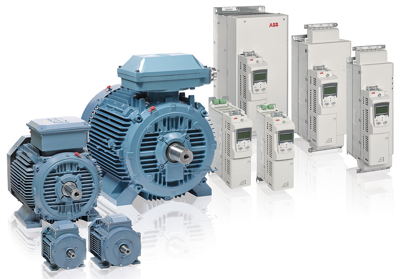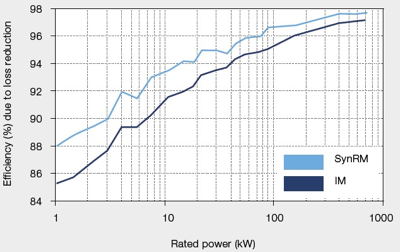Synchronous reluctance motors offer a choice of high outputs or IE4 efficiency
![]() ABB is turning to a synchronous reluctance motor technology for new generations of high-efficiency and high power-density motors. At the recent Hannover Fair, it unveiled two ranges based on these motors: one designed to operate at the “super premium” levels of efficiency likely to be defined in the forthcoming IE4 specification; the other optimised to deliver a high output from a small frame.
ABB is turning to a synchronous reluctance motor technology for new generations of high-efficiency and high power-density motors. At the recent Hannover Fair, it unveiled two ranges based on these motors: one designed to operate at the “super premium” levels of efficiency likely to be defined in the forthcoming IE4 specification; the other optimised to deliver a high output from a small frame.

Both ranges of motors will be sold packaged with variable speed drives – they cannot be used as fixed-speed machines connected directly to a power supply. ABB claims that the packages (shown above) will cut energy losses by up to 40% compared to IE2 induction motors – or allow motors up to two frames smaller than normal to be used to achieve a given output.
The high-efficiency packages will pay for themselves in as little as two years, it says, while an 11kW version of the high-power variant will weigh around 50kg – about half as much as a conventional IE2 induction machine.
In opting for a synchronous reluctance (SynRM) technology, ABB is taking a different path from other motor manufacturers who have chosen permanent magnet (PM) machines to achieve IE4 levels of efficiency. Both camps agree, however, that traditional induction motors (IMs) are unlikely to deliver IE4 efficiency at a competitive price.

ABB’s synchronous reluctance motors combine a conventional induction motor stator with a loss-free rotor constructed from axially stacked iron laminations (shown in the foreground above). The diagram below shows a cross-section of a conventional induction motor (left) compared to that of a synchronous reluctance motor (right) which has a similar stator, but a laminated rotor with no windings. The rotor cross-section has a four-pole structure with four high-permeable axes (with a low magnetic reluctance in iron) and four low-permeable axes (with a high magnetic reluctance in air).

Unlike in a switched reluctance (stepper) motor, the currents in the stator windings are sinusoidal, resulting in smooth operation. In the high-efficiency versions, the drive packages will achieve losses 40% lower than standard motors, resulting in payback periods as short as two years in some applications.
The simple rotor, with no magnets or cages, is said to be more robust that either PM or induction machines. There is also no risk of losing performance as the result of demagnetisation caused by overheating or other failures. Also, because there are no magnets, no back-EMF voltages are induced, making the motors inherently safe and avoiding the need to protect the converters. Possible supply problems and high costs arising from China’s current dominance of the global market for rare-earth magnet materials are also avoided.

The synchronous rotation of the rotor avoids the slip losses which account for 20–35% of the total losses in a conventional induction motor. This results in efficiency improvements ranging from 8% for a 3kW machine, to about 0.6% for a 220kW motor. The graph above shows how SynRM motor efficiencies exceed those of induction motors, especially at lower ratings.
There is also claimed to be a 20–40% increase in power and torque density for the same insulation temperature class. In addition, says ABB, there are VSD efficiency gains ranging from more than 5% for single-kW machines, to around 0.5% for the largest motors (frame 315). So, where an induction machine would need to run at a Class F temperature rise (105K), the synchronous reluctance equivalent operates at a Class A rise (60K). This low-temperature operation extends the life of the insulation and bearings, leading to extended greasing intervals, reduced maintenance and increased reliability, according to ABB.
“Even if a bearing eventually needs replacing, having no magnetic forces – unlike a permanent magnet motor – the bearing will be as easy to change as in an induction motor,” points out Åke Andersson, technical manager of ABB Low Voltage Motors.
A final attraction of avoiding magnets and cages is that the rotor inertia will be 30–50% lower than usual, according to ABB. This will have benefits in highly dynamic applications such as cranes, both in terms of efficiency and of higher speed ramp rates resulting in faster lifting cycles.
ABB cites the example of a 37kW IE4 SynRM motor operating for 8,760 hours per year at 1,500 rpm. Its losses will be 1.1kW less than those of a conventional IE2 induction machine. So the annual cost savings (based on electricity costing €0.1/kWh) will be €964, giving a payback period of around two years and reducing CO2 emissions by 4.8 tonnes per year.
The other version of ABB’s new motor, optimised for high outputs, operates at conventional B or F class temperatures. These motors’ losses are typically 10–20% lower than for induction machines (compared to the 40% achieved by the IE4 versions). For motors rated at 3 or 4kW, up to 60% more power can be obtained for the same temperature rise, ABB says. For a 60kW motor the increase is about 40% compared to a standard induction machine, and for a 200kW motor, it is around 20%. In most cases, this will allow the use of motors one or two frame sizes smaller to achieve the same power output.
There will also be a reduced heat load – a particular advantage in enclosed cabinets. The reduced rotor losses will eliminate much of the usual heat conduction via the shaft, lowering bearing temperatures, especially at the drive end. For a 6kW machine, the temperature reduction compared to an induction motor could be 30K, ABB claims, with a reduction of 15–20K being typical across the entire rating range up to 315kW. The effect is particularly pronounced at higher speeds and for higher temperature classes.
Another attraction of the synchronous reluctance design is that efficiencies remain high even at partial loads, which is expected to be useful for fan and pump drive applications.
According to Åke Andersson, the high-output motors will give customers the best of two worlds: “the performance of a permanent magnet motor and robustness of an induction motor”.
“Machine-builders no longer have to choose between power and compactness,” he adds. “Now they are offered both.”
The synchronous reluctance motor is not a new idea – it was invented in 1923 – but it was not adopted widely for industrial applications because of its inability to be used direct-on-line. Also, early assessments, based on inferior converter technologies, under-estimated the motor’s torque and efficiency performance, according to ABB.
Synchronous reluctance motors have also been criticised for needing larger currents than PM motors to achieve similar levels of torque because the rotor needs to be magnetised through the stator. However, ABB argues that motor currents in its SynRM machines are lower than for small induction motors at the same torque and speed, because of their higher efficiency. It concedes, however, that for larger machines, the current can be higher than for an induction machine at the same torque level.
ABB adds that, in general, the synchronous reluctance machines will have the same frame size for a given drive as an induction motor at the same power and torque level, but with a higher power density and efficiency. At the drive system level, the energy saving is almost the same. And the power factor seen by the network is near unity in all operating modes.
ABB has adapted its DTC (direct torque control) drive technology to work with the new motors at speeds up to 6,000 rpm. The software optimises torque production to minimise the drive current at each operating point. The control technology also works in the field-weakening range (above the rated speed) and can reach speeds 1.5 times higher than the nominal ratings for much of motor’s range. The controls also allow the SynRM motors to reach much higher torque densities than induction machines, says ABB.
It adds that installing and operating the SynRM drives should be no different from using a VSD with an induction or PM motor. The motors can maintain speeds accurately and offer high torque dynamics without needing speed sensors.
ABB is planning to produce the IE4 versions of its synchronous reluctance motors in ratings from 11–200kW (with cast-iron frames sized from 160–315) and the high-output versions in ratings from 1–55kW (in aluminium frame sizes 90–132) and on up to 315kW (in cast-iron frame sizes 160–315). They will be sold with versions of ABB’s ACS850 drive containing the software designed to control the synchronous reluctance machines. They are expected to reach the market from June.
♦ ABB is not the only company promoting synchronous reluctance motors for super premium efficiency applications. The Italian motor-maker Itaco/Reel, controlled by the German pump-maker KSB, is offering a range of these drive systems in ratings from 200W to 61kW, with nominal torque ratings from 1.1–261Nm. It claims that the motors offer 25–80% more power and 30–50% less inertia than similar-sized asynchronous machines.





